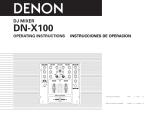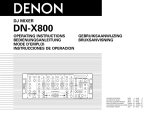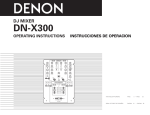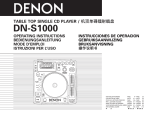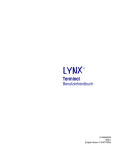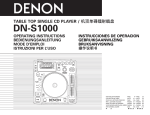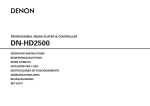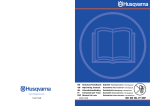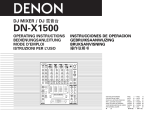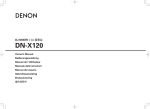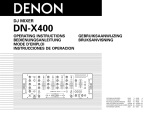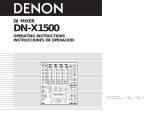Download Denon DN-X300 DJ Equipment User Manual
Transcript
DJ MIXER / DJ 混音台 DN-X300 OPERATING INSTRUCTIONS BEDIENUNGSANLEITUNG MODE D’EMPLOI ISTRUZIONI PER L’USO INSTRUCCIONES DE OPERACION GEBRUIKSAANWIJZING BRUKSANVISNING 操作說明書 FOR ENGLISH READERS FÜR DEUTSCHE LESER POUR LES LECTEURS FRANCAIS PER IL LETTORE ITALIANO PARA LECTORES DE ESPAÑOL VOOR NEDERLANDSTALIGE LEZERS FOR SVENSKA LÄSARE 中 文 PAGE 5 SEITE 11 PAGE 17 PAGINA 23 PAGINA 29 PAGINA 35 SIDA 41 第 47 頁 ~ ~ ~ ~ ~ ~ ~ ~ PAGE 10 SEITE 16 PAGE 22 PAGINA 28 PAGINA 34 PAGINA 40 SIDA 46 第 53 頁 SAFETY INSTRUCTIONS CAUTION 1. Read Instructions – All the safety and operating instructions should be read before the product is operated. 2. Retain Instructions – The safety and operating instructions should be retained for future reference. 3. Heed Warnings – All warnings on the product and in the operating instructions should be adhered to. 4. Follow Instructions – All operating and use instructions should be followed. 5. Cleaning – Unplug this product from the wall outlet before cleaning. Do not use liquid cleaners or aerosol cleaners. The lightning flash with arrowhead symbol, within an equilateral triangle, is intended to alert the user to the presence of uninsulated “dangerous voltage” within the product’s enclosure that may be of sufficient magnitude to constitute a risk of electric shock to persons. 6. Attachments – Do not use attachments not recommended by the product manufacturer as they may cause hazards. 7. Water and Moisture – Do not use this product near water – for example, near a bath tub, wash bowl, kitchen sink, or laundry tub; in a wet basement; or near a swimming pool; and the like. The exclamation point within an equilateral triangle is intended to alert the user to the presence of important operating and maintenance (servicing) instructions in the literature accompanying the appliance. 8. Accessories – Do not place this product on an unstable cart, stand, tripod, bracket, or table. The product may fall, causing serious injury to a child or adult, and serious damage to the product. Use only with a cart, stand, tripod, bracket, or table recommended by the manufacturer, or sold with the product. Any mounting of the product should follow the manufacturer’s instructions, and should use a mounting accessory recommended by the manufacturer. RISK OF ELECTRIC SHOCK DO NOT OPEN CAUTION: TO REDUCE THE RISK OF ELECTRIC SHOCK, DO NOT REMOVE COVER (OR BACK). NO USER SERVICEABLE PARTS INSIDE. REFER SERVICING TO QUALIFIED SERVICE PESONNEL. WARNING: TO PREVENT FIRE OR SHOCK HAZARD, DO NOT EXPOSE THIS APPLIANCE TO RAIN OR MOISTURE. 9. CAUTION: LABELS: 1. Handle the power supply cord carefully Do not damage or deform the power supply cord. If it is damaged or deformed, it may cause electric shock or malfunction when used. When removing from wall outlet, be sure to remove by holding the plug attachment and not by pulling the cord. 2. Do not open the top cover In order to prevent electric shock, do not open the top cover. If problems occur, contact your DENON dealer. 3. Do not place anything inside Do not place metal objects or spill liquid inside the DJ mixer. Electric shock or malfunction may result. Please, record and retain the Model name and serial number of your set shown on the rating label. Model No. DN-X300 Serial No. CAUTION TO PREVENT ELECTRIC SHOCK, MATCH WIDE BLADE OF PLUG TO WIDE SLOT, FULLY INSERT. ATTENTION POUR ÉVITER LES CHOCS ÉLECTRIQUES, INTERODUIRE LA LAME LA PLUS LARGE DE LA FICHE DANS LA BORNE CORRESPONDANTE DE LA PRISE ET POUSSER JUSQU’ AU FOND. A product and cart combination should be moved with care. Quick stops, excessive force, and uneven surfaces may cause the product and cart combination to overturn. 11. Power Sources – This product should be operated only from the type of power source indicated on the marking label. If you are not sure of the type of power supply to your home, consult your product dealer or local power company. For products intended to operate from battery power, or other sources, refer to the operating instructions. 12. Grounding or Polarization – This product may be equipped with a polarized alternating-current line plug (a plug having one blade wider than the other). This plug will fit into the power outlet only one way. This is a safety feature. If you are unable to insert the plug fully into the outlet, try reversing the plug. If the plug should still fail to fit, contact your electrician to replace your obsolete outlet. Do not defeat the safety purpose of the polarized plug. ANTENNA LEAD IN WIRE GROUND CLAMP ANTENNA DISCHARGE UNIT (NEC SECTION 810-20) ELECTRIC SERVICE EQUIPMENT GROUNDING CONDUCTORS (NEC SECTION 810-21) GROUND CLAMPS POWER SERVICE GROUNDING ELECTRODE SYSTEM (NEC ART 250, PART H) NEC - NATIONAL ELECTRICAL CODE 15. Outdoor Antenna Grounding – If an outside antenna or cable system is connected to the product, be sure the antenna or cable system is grounded so as to provide some protection against voltage surges and built-up static charges. Article 810 of the National Electrical Code, ANSI/NFPA 70, provides information with regard to proper grounding of the mast and supporting structure, grounding of the lead-in wire to an antenna discharge unit, size of grounding conductors, location of antenna-discharge unit, connection to grounding electrodes, and requirements for the grounding electrode. See Figure A. 16. Lightning – For added protection for this product during a lightning storm, or when it is left unattended and unused for long periods of time, unplug it from the wall outlet and disconnect the antenna or cable system. This will prevent damage to the product due to lightning and power-line surges. 17. Power Lines – An outside antenna system should not be located in the vicinity of overhead power lines or other electric light or power circuits, or where it can fall into such power lines or circuits. When installing an outside antenna system, extreme care should be taken to keep from touching such power lines or circuits as contact with them might be fatal. 18. Overloading – Do not overload wall outlets, extension cords, or integral convenience receptacles as this can result in a risk of fire or electric shock. 10. Ventilation – Slots and openings in the cabinet are provided for ventilation and to ensure reliable operation of the product and to protect it from overheating, and these openings must not be blocked or covered. The openings should never be blocked by placing the product on a bed, sofa, rug, or other similar surface. This product should not be placed in a built-in installation such as a bookcase or rack unless proper ventilation is provided or the manufacturer’s instructions have been adhered to. FIGURE A EXAMPLE OF ANTENNA GROUNDING AS PER NATIONAL ELECTRICAL CODE 13. Power-Cord Protection – Power-supply cords should be routed so that they are not likely to be walked on or pinched by items placed upon or against them, paying particular attention to cords at plugs, convenience receptacles, and the point where they exit from the product. 19. Object and Liquid Entry – Never push objects of any kind into this product through openings as they may touch dangerous voltage points or short-out parts that could result in a fire or electric shock. Never spill liquid of any kind on the product. 20. Servicing – Do not attempt to service this product yourself as opening or removing covers may expose you to dangerous voltage or other hazards. Refer all servicing to qualified service personnel. 21. Damage Requiring Service – Unplug this product from the wall outlet and refer servicing to qualified service personnel under the following conditions: a) When the power-supply cord or plug is damaged, b) If liquid has been spilled, or objects have fallen into the product, c) If the product has been exposed to rain or water, d) If the product does not operate normally by following the operating instructions. Adjust only those controls that are covered by the operating instructions as an improper adjustment of other controls may result in damage and will often require extensive work by a qualified technician to restore the product to its normal operation, e) If the product has been dropped or damaged in any way, and f) When the product exhibits a distinct change in performance – this indicates a need for service. 22. Replacement Parts – When replacement parts are required, be sure the service technician has used replacement parts specified by the manufacturer or have the same characteristics as the original part. Unauthorized substitutions may result in fire, electric shock, or other hazards. 23. Safety Check – Upon completion of any service or repairs to this product, ask the service technician to perform safety checks to determine that the product is in proper operating condition. 24. Wall or Ceiling Mounting – The product should be mounted to a wall or ceiling only as recommended by the manufacturer. 25. Heat – The product should be situated away from heat sources such as radiators, heat registers, stoves, or other products (including amplifiers) that produce heat. 2 ENGLISH DEUTSCH FRANÇAIS ITALIANO ESPAÑOL NEDERLANDS SVENSKA TOP PANEL DIAGRAM / OBERES BEDIENFELD-SCHEMA / SCHEMA DU PANNEAU SUPERIEUR / SCHEMA PANNELLO SUPERIORE/ DIAGRAMA DEL PANEL SUPERIOR / OVERZICHT VAN BOVENPANEEL / BILD ÖVER ÖVERSTA PANELEN / 頂面板視圖 REAR PANEL DIAGRAM / HINTERES ANSCHLUSSFELD-SCHEMA / SCHEMA DU PANNEAU ARRIERE / SCHEMA PANNELLO POSTERIORE / DIAGRAMA DEL PANEL POSTERIOR / OVERZICHT VAN ACHTERPANEEL / BAKPANELEN / 後面板視圖 t yu i o !0!0 o i !1 y t r !2 e !3 @4 @5 @6 @7 @8 !4 w !5 q !6 !7 !7 !8 !9 !9 @0 @1 #7 #6 #5 #4 #3 #2 #1 #0 #3 #2 #1 #0 @9 FRONT PANEL DIAGRAM / VORDERES BEDIENFELD-SCHEMA / SCHEMA DU PANNEAU AVANT / SCHEMA PANNEAU AVANT / DIAGRAMA DEL PANEL FRONTAL / OVERZICHT VAN VOORPANEEL / FRONTPANELEN / 前面板視圖 #8 #9 $2 $1 $4 #9 #8 @1 @2 @3 3 $3 $2 $1 $0 NOTE ON USE / HINWEISE ZUM GEBRAUCH / OBSERVATIONS RELATIVES A L’UTILISATION / NOTE SULL’USO NOTAS SOBRE EL USO / ALVORENS TE GEBRUIKEN / OBSERVERA • Avoid high temperatures. Allow for sufficient heat dispersion when installed on a rack. • Vermeiden Sie hohe Temperaturen. Beachten Sie, daß eine ausreichend Luftzirkulation gewährleistet wird, wenn das Gerät auf ein Regal gestellt wird. • Eviter des températures élevées Tenir compte d’une dispersion de chaleur suffisante lors de l’installation sur une étagère. • Evitate di esporre l’unità a temperature alte. Assicuratevi che ci sia un’adeguata dispersione del calore quando installate l’unità in un mobile per componenti audio. • Evite altas temperaturas Permite la suficiente dispersión del calor cuando está instalado en la consola. • Vermijd hoge temperaturen. Zorg voor een degelijk hitteafvoer indien het apparaat op een rek wordt geplaatst. • Undvik höga temperaturer. Se till att det finns möjlighet till god värmeavledning vid montering i ett rack. • Handle the power cord carefully. Hold the plug when unplugging the cord. • Gehen Sie vorsichtig mit dem Netzkabel um. Halten Sie das Kabel am Stecker, wenn Sie den Stecker herausziehen. • Manipuler le cordon d’alimentation avec précaution. Tenir la prise lors du débranchement du cordon. • Manneggiate il filo di alimentazione con cura. Agite per la spina quando scollegate il cavo dalla presa. • Maneje el cordón de energía con cuidado. Sostenga el enchufe cuando desconecte el cordón de energía. • Hanteer het netsnoer voorzichtig. Houd het snoer bij de stekker vast wanneer deze moet worden aan- of losgekoppeld. • Hantera nätkabeln varsamt. Håll i kabeln när den kopplas från el-uttaget. • Keep the set free from moisture, water, and dust. • Halten Sie das Gerät von Feuchtigkeit, Wasser und Staub fern. • Protéger l’appareil contre l’humidité, l’eau et lapoussière. • Tenete l’unità lontana dall’umidità, dall’acqua e dalla polvere. • Mantenga el equipo libre de humedad, agua y polvo. • Laat geen vochtigheid, water of stof in het apparaat binnendringen. • Utsätt inte apparaten för fukt, vatten och damm. • Unplug the power cord when not using the set for long periods of time. • Wenn das Gerät eine längere Zeit nicht verwendet werden soll, trennen Sie das Netzkabel vom Netzstecker. • Débrancher le cordon d’alimentation lorsque l’appareil n’est pas utilisé pendant de longues périodes. • Disinnestate il filo di alimentazione quando avete l’intenzione di non usare il filo di alimentazione per un lungo periodo di tempo. • Desconecte el cordón de energía cuando no utilice el equipo por mucho tiempo. • Neem altijd het netsnoer uit het stopkontakt wanneer het apparaat gedurende een lange periode niet wordt gebruikt. • Koppla ur nätkabeln om apparaten inte kommer att användas i lång tid. ✽ (For sets with ventilation holes) • Do not obstruct the ventilation holes. • Die Belüftungsöffnungen dürfen nicht verdeckt werden. • Ne pas obstruer les trous d’aération. • Non coprite i fori di ventilazione. • No obstruya los orificios de ventilación. • De ventilatieopeningen mogen niet worden beblokkeerd. • Täpp inte till ventilationsöppningarna. CAUTION • The ventilation should not be impeded by covering the ventilation openings with items, such as newspapers, table-cloths, curtains, etc. • No naked flame sources, such as lighted candles, should be placed on the apparatus. 4 • Do not let foreign objects in the set. • Keine fremden Gegenstände in das Gerät kommen lassen. • Ne pas laisser des objets étrangers dans l’appareil. • E’ importante che nessun oggetto è inserito all’interno dell’unità. • No deje objetos extraños dentro del equipo. • Laat geen vreemde voorwerpen in dit apparaat vallen. • Se till att främmande föremål inte tränger in i apparaten. • Do not let insecticides, benzene, and thinner come in contact with the set. • Lassen Sie das Gerät nicht mit Insektiziden, Benzin oder Verdünnungsmitteln in Berührung kommen. • Ne pas mettre en contact des insecticides, du benzène et un diluant avec l’appareil. • Assicuratevvi che l’unità non venga in contatto con insetticidi, benzolo o solventi. • No permita el contacto de insecticidas, gasolina y diluyentes con el equipo. • Laat geen insektenverdelgende middelen, benzine of verfverdunner met dit apparaat in kontakt komen. • Se till att inte insektsmedel på spraybruk, bensen och thinner kommer i kontakt med apparatens hölje. • DECLARATION OF CONFORMITY We declare under our sole responsibility that this product, to which this declaration relates, is in conformity with the following standards: EN60065, EN55013, EN55020, EN61000-3-2 and EN61000-3-3. Following the provisions of 73/23/EEC, 89/336/EEC and 93/68/EEC Directive. • ÜBEREINSTIMMUNGSERKLÄRUNG Wir erklären unter unserer Verantwortung, daß dieses Produkt, auf das sich diese Erklärung bezieht, den folgenden Standards entspricht: EN60065, EN55013, EN55020, EN61000-3-2 und EN61000-3-3. Entspricht den Verordnungen der Direktive 73/23/EEC, 89/336/EEC und 93/68/EEC. • DECLARATION DE CONFORMITE Nous déclarons sous notre seule responsabilité que l’appareil, auquel se réfère cette déclaration, est conforme aux standards suivants: EN60065, EN55013, EN55020, EN61000-3-2 et EN61000-3-3. D’après les dispositions de la Directive 73/23/EEC, 89/336/EEC et 93/68/EEC. • DICHIARAZIONE DI CONFORMITÀ Dichiariamo con piena responsabilità che questo prodotto, al quale la nostra dichiarazione si riferisce, è conforme alle seguenti normative: EN60065, EN55013, EN55020, EN61000-3-2 e EN61000-3-3. In conformità con le condizioni delle direttive 73/23/EEC, 89/336/EEC e 93/68/EEC. QUESTO PRODOTTO E’ CONFORME AL D.M. 28/08/95 N. 548 • DECLARACIÓN DE CONFORMIDAD Declaramos bajo nuestra exclusiva responsabilidad que este producto al que hace referencia esta declaración, está conforme con los siguientes estándares: EN60065, EN55013, EN55020, EN61000-3-2 y EN61000-3-3. Siguiendo las provisiones de las Directivas 73/23/EEC, 89/336/EEC y 93/68/EEC. • EENVORMIGHEIDSVERKLARING Wij verklaren uitsluitend op onze verantwoordelijkheid dat dit produkt, waarop deze verklaring betrekking heeft, in overeenstemming is met de volgende normen: EN60065, EN55013, EN55020, EN61000-3-2 en EN61000-3-3. Volgens de bepalingen van de Richtlijnen 73/23/EEC, 89/336/EEC en 93/68/EEC. • ÖVERENSSTÄMMELSESINTYG Härmed intygas helt på eget ansvar att denna produkt, vilken detta intyg avser, uppfyller följande standarder: EN60065, EN55013, EN55020, EN61000-3-2 och EN61000-3-3. Enligt stadgarna i direktiv 73/23/EEC, 89/336/EEC och 93/68/EEC. FCC INFORMATION (For US customers) • Never disassemble or modify the set in any way. • Versuchen Sie niemals das Gerät auseinander zu nehmen oder auf jegliche Art zu verändern. • Ne jamais démonter ou modifier l’appareil d’une manière ou d’une autre. • Non smontate mai, nè modificate l’unità in nessun modo. • Nunca desarme o modifique el equipo de ninguna manera. • Nooit dit apparaat demonteren of op andere wijze modifiëren. • Ta inte isär apparaten och försök inte bygga om den. • Please be care the environmental aspects of battery disposal. • The apparatus shall not be exposed to dripping or splashing for use. • No objects filled with liquids, such as vases, shall be placed on the apparatus. 1. PRODUCT 3. NOTE This product complies with Part 15 of the FCC Rules. Operation is subject to the following two conditions: (1) this product may not cause harmful interference, and (2) this product must accept any interference received, including interference that may cause undesired operation. This product has been tested and found to comply with the limits for a Class B digital device, pursuant to Part 15 of the FCC Rules. These limits are designed to provide reasonable protection against harmful interference in a residential installation. This product generates, uses and can radiate radio frequency energy and, if not installed and used in accordance with the instructions, may cause harmful interference to radio communications. However, there is no guarantee that interference will not occur in a particular installation. If this product does cause harmful interference to radio or television reception, which can be determined by turning the product OFF and ON, the user is encouraged to try to correct the interference by one or more of the following measures: • Reorient or relocate the receiving antenna. • Increase the separation between the equipment and receiver. • Connect the product into an outlet on a circuit different from that to which the receiver is connected. • Consult the local retailer authorized to distribute this type of product or an experienced radio/TV technician for help. 2. IMPORTANT NOTICE: DO NOT MODIFY THIS PRODUCT This product, when installed as indicated in the instructions contained in this manual, meets FCC requirements. Modification not expressly approved by DENON may void your authority, granted by the FCC, to use the product. ENGLISH 2 INTRODUCTION 2 PART NAMES AND FUNCTIONS Thank you very much for purchasing the DENON DN-X300 DJ MIXER. DENON proudly presents this advanced DJ MIXER to audiophiles and music lovers as a further proof of DENON’s non-compromising pursuit of the ultimate in sound quality. The high quality performance and easy operation are certain to provide you with many hours of outstanding listening pleasure. (1) Top panel – TABLE OF CONTENTS – z x c MAIN FEATURES ...............................................5 PART NAMES AND FUNCTIONS ...................5, 6 CONNECTIONS ..................................................7 2 ACCESSORIES Please check to make sure the following items are included with the main unit in the carton: v b n SPECIFICATIONS................................................8 FADER START ....................................................9 ROTATING INPUT SELECT SWITCHES ...........10 w MIC EQ controls • Contour the frequency response of the MIC input –12 dB to +12 dB. • At the center position, sound is flat. • Adjusts the level of Mic signal. r AUX INPUT control • Adjusts the level of AUX input. • This input is mixed after the Crossfader and EFFECT LOOP. t Source EQ controls 02. VCA controlled Channel Fader and Crossfader 06. Channel Reverse function This function allows the left hand channel fader or right hand channel fader to control PGM1 or PGM2. 03. Channel Fader and Crossfader curve adjustable This feature allows adjusting the “shape” of the Crossfader and Channel fader response from a gentle curve for smooth to the steep pitch required for top performance cut and scratch effects. 07. Enhanced Input/Output terminals 4 LINE, 2 PHONO, 1 AUX, 1 Microphone systems, 2 MASTER outputs and 1 BOOTH output are provided independently. Effect SEND/RETURN terminals are also provided for a external effects processor. 04. Channel Fader and Crossfader Reverse 08. 3-Band equalizer/gain LOW, MID, HI and GAIN controls are available on every input channel. 05. Channel Fader and Crossfader Start The CD player can be started or stopped simply by increasing or decreasing the level of the Ch. fader or by using the Crossfader left to right or right to left. (This function can only be used when the DENON CD players DN-S3000, DN-S5000, DNS1000 or etc. is connected to the DN-X300.) • When TALKOVER is selected , all signals except the microphone level are decreased by 20 dB. When at the ON or OFF position all signals remain at their standard levels. e MIC LEVEL control q Operating instructions.......................................1 w AC adaptor ........................................................1 (AA-26 : for AC 120 V, AA-27 : for AC 230 V) 1 MAIN FEATURES 01. Penny & Giles Crossfader Smooth and reliable mixing is excelled by Penny & Giles Crossfader. q MIC ON/OFF/TALKOVER switch 09. 3-Band Equalizer Kill function 10. 8 direction placement for input selector 11. Microphone Talkover function • Contour the frequency response of the selected inputs. HI and MID: • Adjusts the high-tone and mid-tone sound –40 dB to +10 dB. LOW: • Adjusts the low-tone sound –40 dB to +6 dB. NOTE: Clipping may occur if adjustments are set to harsh. y GAIN control • Adjusts the gain of each input channel. u EFFECT LOOP WET/DRY control • Use this to adjust the ratio of original and effected sound. i EQ ON/OFF button • When the LED is lit, EQ is ON. Otherwise EQ is bypassed. o PGM BALANCE control • Adjusts the L/R balance of the PGM input. (Refer to page 3.) !0 EFFECT LOOP ON/OFF switch • Routes the assigned signal through the external processor attached to the SEND/RETURN connectors on the rear. • When the EFFECT LOOP is ON, the LED is lit. (When the external processor isn’t connected, the LED will blink.) !1 CH REVERSE button • This switch allows the left hand fader or right hand fader to control PGM1 or PGM2. • When the CH REVERSE mode is ON, the CH1 fader will be able to control PGM 2 sound and the CH2 fader will be able to control PGM 1 sound. NOTE: Please don’t confuse with the CH 1/2 FADER REVERSE switch $4. !2 MASTER LEVEL control • Adjust the level of the MASTER outputs. !3 BOOTH OUTPUT control • Adjusts the level of BOOTH output. !4 CUE SELECT switch • This switch is used to select the signal for CUE. Selected CUE sound will send to the headphone. !5 Headphone PAN control • This function allows you to monitor the CUE level as well as the MASTER output in your headphones. A CUE Level may only be monitored of the CUE signal is selected. • Serves two purposes…In the STEREO mode it changes the relative levels of the CUE and MASTER mixed together in both ear cups. In the SPLIT CUE mode it changes the balance between the monaural CUE sound in the left and monaural MASTER sound in the right. !6 PHONES LEVEL control • Adjusts the headphone output level. 5 ENGLISH !7 Input select switch • Switches between the PHONO/LINE and LINE inputs. • When the lever of switch is vertical position, the LINE2 or LINE4 input is selected. • When the lever of switch is slope, the PHONO1/LINE1 or PHONO2/lINE3 input is selected. • You can perform 8 direction placement. See page 10. !8 SPLIT CUE button • In the STEREO mode, the stereo sound of MASTER and CUE are fed to both ear cups. In the SPLIT CUE mode, the headphone circuit provides monaural CUE sound to the left and monaural MASTER sound to the right. • When the Level Meter mode select switch is set to “MASTER”…In the STEREO mode, the meter indicates the stereo level in the L/R Master output. In the SPLIT CUE mode, the monaural CUE sound level is displayed on the left and the monaural MASTER sound level is displayed on the right. • In the SPLIT CUE mode, the LED is lit. !9 PGM 1/2 KILLS switches • These switches are used cut out the Treble, Mid or Bass frequencies of the incoming audio signal. When these switches moved up or down, the selected frequency level is cut, the LED located directly above the specific switch will glow indicating the cut function has been activated. @0 Level meter mode select switch • The position of this switch will determine the Level Meter mode. In the “MASTER” position, the meter will detail the out level of the left and right channels. In the “PGM 1/2” position, the left side of the meter will indicate monaural level of the PGM 1 and the right side of the meter will indicate monaural level of the PGM 2. @1 Channel Fader • Controls the channel output level. @2 Level meter • The dual LED's indicators are used to detail either the master output level, a combination of the master output level and the CUE signal level, or the PGM1/2 monaural level. @3 Crossfader • Fades the overall mixer output between channels 1 and 2. 6 (2) Rear panel @4 Power operation switch (POWER) • Selects power “ON” or “OFF”. NOTE: Whenever the power switch is in the OFF state, the AC adaptor is still connected on AC line voltage. Please be sure to unplug the cord when you don’t use for along time. @5 BALANCED MASTER OUT jacks • These 1/4” TRS jacks provide a balanced line level output. • Connect these jacks to the balanced analog input jacks on an amplifier or console. • Pin layout: Tip=Hot Ring=Cold Sleeve=GND @6 EFFECT LOOP SEND/RETURN jacks • These 1/4” TS stereo jacks allow external processing of the program signal. • When connect monaural type effect processor, use Lch input and output. @7 MIC BALANCED INPUT jack • Accepts an balanced microphone with 1/4” TRS mono jacks. • Pin layout: Tip=Hot Ring=Cold Sleeve=GND @8 MIC EFFECT LOOP jack • These 1/4” TRS jack allow external processing of the program signal. • Pin layout: Tip=SEND Ring=RETURN Sleeve=GND @9 PGM1, 2 FADER output jacks • Connect these jacks to the FADER input jacks of DN-S3000, DN-S5000, DN-S1000 and etc. using the 3.5mm stereo mini cord. #0 Phono ground screw (GND) • This screws provide a place to connect the ground wire from a turntable. • This terminal is exclusively for a turntable ground and not a safety earth ground. #1 PHONO1, 2 / LINE1, 3 switches (LN / PH) • These switches change the input from PHONO to a LINE level input. • These switches set a LINE level input when turntable is not connected. NOTE: Always be sure main power is shut off before change the position of the Line Level Selector Switch. (3) Front panel #2 PHONO1, 2 / LINE1, 3 input jacks • These stereo pairs of unbalanced RCA jacks are inputs for a PHONO (RIAA) stage for magnetic (MM) cartridges or a LINE stage suitable for any device, such as a CD player. #3 LINE2, 4 input jacks • These stereo pairs of unbalanced RCA jacks are inputs for any line level device. #4 AUX INPUT jacks • This stereo pair of RCA jacks provides an unbalanced line level input with independent top panel AUX INPUT control. • This input is mixed after the Crossfader and EFFECT LOOP. #5 BOOTH OUT jacks • This stereo pair of RCA jacks is the same as the MASTER output with independent BOOTH LEVEL control. • This output may be for recording, booth/zone monitoring, or for connecting to another mixer. #6 UNBALANCED MASTER OUT jacks • This stereo pair of RCA jacks provides an unbalanced line level output. • Connect these jacks to the unbalanced analog input jacks on an amplifier or console. #7 AC IN • Input connection for the included AC adaptor. NOTE: Use specified attached AC adaptor only. #8 CH 1/2 FADER START switches • Use this to switch the Channel Fader Start function ON and OFF. #9 CROSSFADER START A, B switches • Use this to switch the Crossader Start function ON and OFF. $0 HEADPHONE output jack • Accept 1/4” stereo headphone plugs. $1 CH 1/2 FADER CONTOUR adjustment • Adjusts the curve of the CH1/2 faders between fast, normal , or slow fade. $2 CH 1/2 FADER REVERSE switch • Reverses the direction of each respective input CH1/2 fader. $3 CROSSFADER CONTOUR adjustment • Adjusts the shape of the crossfader curve from a fast cut for scratching or to a slow fade for mixing. $4 CROSSFADER REVERSE switch • Reverses the direction of the crossfader. ENGLISH Main balanced power amplifier Balanced microphone Effects processor Effects processor IN OUT R 1/4” TRS mono jack L 1/4” TS jack. R 1/4” TS jack L 1/4” TS jack R 1/4” TS jack DN-X300 1/4” TRS jack 1/4” TRS jack Send (Tip) L Return (Ring) 1/4” TRS jack AA-26 : for AC 120V AA-27 : for AC 230V AA-26 or AA-27 R L R R L R L R R L L R L To power outlet 3 3 4 4 1 3 210 1 2 2 765 ANTI-S TING KA 765 ANTI-S TING KA 0 KEY ADJUST 0 PITCH KEY ADJUST -12 SLOW BRAKE PITCH -12 SLOW BRAKE Quartz Quartz 0 ON OFF 0 ON OFF POWER POWER +12 START /STOP START /STOP 78 33 +12 45 DP-DJ151 Digital Turntable 2 78 33 45 3.5 mm stereo mini cord L 3.5 mm stereo mini cord AC adaptor 4 1. Make certain AC power is off while making connections. 2. Quality cables make a big difference in fidelity and punch. Use high-quality, audio cables. 3. Do not use excessively long cables. Be sure plugs and jacks are securely fastened. Loose connections cause hum, noise, or intermittents that could damage your speakers. 4. Connect all stereo input sources. Then connect any effects into the stereo effect, if used. Connect your microphone(s) and monitor headphones. Make sure all faders are at “zero” and the unit is off. Take care to connect only one cable at a time. pay attention to L and R position of jacks, on both the DN-X300 and outboard gear. 5. Connect the stereo outputs to the power amplifier(s) and/or tape deck(s) and/or MD recorder(s) and/or CD recorder(s). Plug the DN-X300 into AC power outlet. 3 210 Refer to the connection diagram below. NOTE: Always switch on your audio input sources such as CD players first, then your mixer, and finally any amplifiers. When turning off, always reverse this operation by turning off amplifiers, then your mixer, and then input units. 4 3 CONNECTIONS DP-DJ151 Digital Turntable 1 NOTE: Use specified attached AC adaptor only. Main unbalanced power amplifier Booth unbalanced power amplifier Mixer CD player CD player 7 ENGLISH 4 SPECIFICATIONS • Phono Inputs: Input Impedance Level 2 Stereo 50 kΩ/kohms –50 dBV (3 mV) Unbalanced RCA jacks • Line Inputs: Input Impedance Level 2 Stereo 20 kΩ/kohms –14 dBV (200 mV) Unbalanced RCA jacks • Return Inputs: Input Impedance Level Stereo 20 kΩ/kohms –14 dBV (200 mV) Unbalanced 1/4” TS jack • Aux Inputs Input Impedance Level Stereo 20 kΩ/kohms –14 dBV (200 mV) Unbalanced RCA jacks • Mic Inputs: Input Impedance Level Frequency Response S/N 1 Mono 2 kΩ/kohms –54 dBV (2 mV) 20 Hz to 20 kHz (±3 dB) 66dB Active Balanced 1/4” TRS jack • EQ Control (Mic): Control Range 2 Bands HI : –12 to +12 dB (at 10 kHz) LOW : –12 to +12 dB (at 100 Hz) • Mic Return Inputs: Input Impedance Level 1 Mono 20 kΩ/kohms –14 dBV (200 mV) Ring of 1/4” TRS jack • Master Output: Balanced Output Impedance Level Frequency Response THD+N S/N Cross Talk Unbalanced Output Impedance Level Frequency Response THD+N S/N Cross Talk Stereo 150 Ω/ohms +4 dBm (1.23 Vrms) 20 Hz to 20 kHz (±2 dB) LINE : Below 0.05 % LINE : 90 dB Over 75 dB Stereo 1 kΩ/kohms 0 dBV (1 Vrms) 20 Hz to 20 kHz (±2 dB) LINE : Below 0.05 % LINE : 90 dB Over 75 dB Active Balanced 1/4” TRS jack • Booth Output: Output Impedance Level Stereo 1 kΩ/kohms 0 dBV (1 Vrms) Unbalanced RCA jacks • Send Output: Output Impedance Level Stereo 1 kΩ/kohms –14 dBV (200 mVrms) Unbalanced 1/4” TS jacks Tip of 1/4” TRS jacks (10 kΩ/kohms load) • Headphone Output: Output Impedance Level Stereo 33 Ω/ohms 0 dBV (1 Vrms) (32 Ω/ohms load) • Power Source: AC 10 V 750 mA x 2 • Power Supply, Consumptions: USA, Canada AC 120 V ± 10 %, 60 Hz Europe, Asia, Oceania AC 230 V ± 10 %, 50 Hz (AC adaptor : AA-26) (AC adaptor : AA-27) • Unit Size 228 (W) x 326 (D) x 90 (H) mm • Mass Unit : 3.8 kg AC adaptaor : 0.5 kg ✽ Specifications and design are subject to change without notice for purpose of improvement. 203 33 25.25 35.25 10 228 19.8 ø18.2 306 326 PHONO : Below 0.07 % PHONO : 79 dB 241 (600 Ω/ohms load) Unbalanced RCA jacks (10 kΩ/kohms load) 20 PHONO : Below 0.07 % PHONO : 79 dB 219.3 82.4 20 (10 kΩ/kohms load) (10 kΩ/kohms load) 140 7.6 8 3 Bands HI : –30 dB to +10 dB (at 16 kHz), –38 dB to +10 dB (at 20 kHz) MID : –38 dB to +10 dB (at 01 kHz) LOW : –38 dB to +06 dB (at 060 Hz) 1 mono 1 kΩ/kohms –14 dBV (200 mVrms) 255.5 • EQ Control (Line): Control Range • Mic Send Output: Output Impedance Level ENGLISH 5 FADER START Channel Fader Start If the separately sold DN-S5000, DN-S3000, DN-S1000 and etc. players are connected to LINE1, 2, 3 or 4, they can be started using the source input fader (Ch. Fader) or Crossfader, as long as the 3.5 mm stereo mini cords have been connected. Crossfader Start Turn the CH 1/2 FADER START switches #8. 1 Turn the CROSSFADER START A, B switches #9. 1 Slide the Crossfader @3 all the way in direction opposite the source you want to start. (In the following example, startup is done with the CD player connected to PGM1.) R L R LINE4 FADER FADER PGM1 L R FADER PGM1 LINE OUT L R 2 2 LINE2 FADER PGM2 DN-X300 CD player (DN-S3000) FADER PGM2 FADER LINE OUT L FADER Move the Channel fader @1 of CH-1 or CH-2 control all the way to the bottom. 3 Set the standby mode on CD player. 4 Use the CH 1/2 FADER CONTOUR controls $1 to control the Channel fader startup curve. FADER CD player (DN-S3000) 5 3 Set the standby mode on CD player. 4 Use the CROSSFADER CONTOUR control $3 to control the Crossfader startup curve. When you want to start the player, move up the Channel fader @1 and the CD player will begin playing. When the Crossfader @3 is slid in the opposite direction, CD player play will begin. 5 NOTE: • When the CH 1/2 FADER REVERSE switch is set to ON, the Channel fader's operating direction is reversed. (1)-2, 5 (1)-2, 5 (2)-2, 5 (2)-1 (2)-1 (1)-1 (1)-1 NOTES: • When the CROSSFADER REVERSE switch is set to ON, the Crossfader's operating direction is reversed. • Channel Fader Start and Crossfader Start for the same source will not operate simultaneously. You must select from either one. If both CH FADER START and CROSSFADER START A, B switches are ON, priority will be the cross fader. (1)-4 (1)-4 (2)-4 9 ENGLISH 6 ROTATING INPUT SELECT SWITCHES About the Cables 1. Disconnect the power. (For RCA in/out jack) 2. Remove knobs from the top panel. RCA pin plug 3. Remove the 6 screws attaching the top panel. Cable 1 Unbalanced 4. Remove the 2 screws attaching the switch unit. 5. Rotate the switch unit to the desired location. 6. Reinstall the 2 screws holding the switch unit. 7. Reinstall the top panel and reattach knobs. NOTE: • Only the knob for CUE SELECT is different. (For SEND/RETURN) Unbalanced (1/4” TS) Cable 2 Unbalanced (1/4” TS) Cable 3 Balanced (1/4” TRS) (For BALANCED MASTER OUT) Balanced (1/4” TRS) Sleeve=GND Ring=Cold Tip=Hot Sleeve=GND Ring=Cold Tip=Hot (For MIC) Balanced (1/4” TRS) Cable 4 Balanced 1=GND 2=Hot Switch unit XLR3-11C Sleeve=GND Ring=Cold Tip=Hot 3=Cold (For BALANCED MASTER OUT) 2=Hot 1=GND 3=Cold Balanced Cable 5 Balanced (1/4” TRS) Sleeve=GND Ring=Cold Tip=Hot XLR3-12C (For MIC EFFECT LOOP) Adaptor R=Ring L=Tip 10 Cable 6 Balanced (1/4” TRS) Sleeve=GND Ring=R Tip=L DEUTSCH 2 EINFÜHRUNG Wir danken Ihnen sehr für den Kauf des DENON DN-X300 DJ MIXER. DENON ist stolz darauf, Audio-Freunden und Musikliebhabern diesen erweiterten DJ MIXER als einen weiteren Beweis der kompromisslosen Bestrebungen von DENON nach Erreichen der ultimativen Klangqualität zu präsentieren. Aufgrund der hochqualitativen Leistungsfähigkeit und der leichten Bedienung dieses Gerätes werden Sie beim Zuhören viele Stunden lang Ihre Freude haben. 2 BEZEICHNUNG DER TEILE UND DEREN FUNKTIONEN (Beziehen Sie sich auf Seite 3.) (1) Oberes bedienfeld q MIC ON/OFF/TALKOVER-Schalter – INHALT – z x c HAUPTMERKMALE..........................................11 BEZEICHNUNG DER TEILE UND DEREN FUNKTIONEN .............................................11, 12 v b n TECHNISCHE DATEN.......................................14 FADER-START ..................................................15 DREHEN DER EINGANGSWAHLSCHALTER.......16 VERBINDUNGEN..............................................13 2 ZUBEHÖR Überprüfen Sie bitte, ob folgende Komponenten zusammen mit der Haupteinheit im Karton vorhanden sind: q Bedienungsanleitung ........................................1 w Wechselstrom-Adapter .....................................1 (AA-26 : für AC 120 V, AA-27 : für AC 230 V) 02. VCA-gesteuerter Channel-Fader und Crossfader w MIC EQ-Regler • Kontur des Frequenzganges des MIC-Einganges –12 dB bis +12 dB. • In der Mittelposition ist der Sound flach. e MIC LEVEL-Regler • Stellt den Pegel des Mik-Signals ein. r AUX INPUT-Regler • Stellt den Pegel des AUX-Eingangspegels. • Dieser Eingang wird nach dem Crossfader und nach dem EFFECT LOOP gemischt. 1 HAUPTMERKMALE 01. Penny & Giles Crossfader Sanftes und zuverlässiges Mischen zeichnet sich durch den Penny & Giles Crossfader aus. • Bei der Auswahl von TALKOVER werden alle Signale außer dem Mikrofonpegel um 20 dB abgesenkt. Bei der Einstellung von ON oder OFF verbleiben alle Signale auf ihren Standardpegeln. t Quellen-EQ-Regler 06. Channel-Umkehrfunktion Diese Funktion ermöglicht dem linken ChannelFader oder dem rechten Channel-Fader die Steuerung von PGM1 oder PGM2. 07. Erweiterte Eingangs-/Ausgangsanschlüsse 4 LINE, 2 PHONO, 1 AUX, 1 Mikrofonsystem, 2 MASTER-Ausgänge und 1 BOOTH-Ausgang sind getrennt voneinander vorhanden. EffektSEND/RETURN-Anschlüsse sind für einen externen Effektprozessor ebenfalls vorhanden. 03. Channel-Fader- und Crossfader-Kurve einstellbar Diese Funktion ermöglicht die Einstellung der “Form” des Crossfader- und Channel-FaderFrequenzganges von einer sanften Kurve für einen geschmeidigen Sound hin zu einem tiefen Pitch, der für einen Top-Leistungscut und für ScratchEffekte erforderlich ist. 08. 3-Band-Equalizer/Verstärkung Die Steuerungen LOW, MID, HI und GAIN sind bei jedem Eingangskanal vorhanden. 04. Channel-Fader- und Crossfader-Umkehrung 09. 3-Band-Equalizer-Kill-Funktion 05. Channel-Fader- und Crossfader-Start Der CD-Player kann einfach durch das Anheben oder Senken des Pegels des Ch.-Faders oder durch Verschieben des Crossfader von links nach rechts oder von rechts nach links gestartet oder gestoppt werden. (Diese Funktion kann nur angewendet werden, wenn die DENON CD-Player DN-S3000, DN-S5000, DN-S1000 usw. am DNX300 angeschlossen sind.) 10. 8-Richtungsplatzierung für den Eingangswähler 11. Mikrofon-Übersprechfunktion • Kontur des Frequenzganges der ausgewählten Eingänge. HI (Hoch) und MID (Mittel): • Stellt den Hochton- und Mitteltonsound zwischen –40 dB und +10 dB ein. LOW (Tief): • Stellt die Tiefen des Sounds ein –40 dB bis +6 dB. HINWEIS: Wenn die Einstellungen zu rau sind, könnte es zum Auftreten von Clipping kommen. y GAIN-Regler • Zur Einstellung der Verstärkung jedes einzelnen Eingangskanals. u EFFECT LOOP WET/DRY-Regler • Damit wird das Verhältnis des Original- und Effektsounds eingestellt. i EQ ON/OFF-Taste • Wenn die LED leuchtet, ist EQ auf ON eingestellt. Anderenfalls wird EQ umgangen. o PGM BALANCE-Regler • Zur Einstellung der L/R-Balance des PGMEingangs. !0 EFFECT LOOP ON/OFF-Schalter • Führt das zugewiesene Signal durch den externen Prozessor, der an den SEND/RETURNAnschlüssen auf der Rückseite angeschlossen ist. • Wenn EFFECT LOOP auf ON eingestellt ist, leuchtet die LED. (Wenn der externe Prozessor nicht angeschlossen ist, blinkt die LED.) !1 CH REVERSE-Taste • Dieser Schalter ermöglicht dem linken Fader oder dem rechten Fader die Steuerung von PGM1 oder PGM2. • Wenn der CH REVERSE-Modus auf ON eingestellt ist, ist der CH1-Fader in der Lage, den PGM 2Sound zu steuern, und der CH2-Fader ist in der Lage, den PGM 1-Sound zu steuern. HINWEIS: Bitte verwechseln Sie diesen Schalter nicht mit dem CH 1/2 FADER REVERSE-Schalter $4. !2 MASTER LEVEL-Regler • Stellt den Pegel der MASTER-Ausgänge ein. !3 BOOTH OUTPUT-Regler • Stellt den Pegel des BOOTH-Ausgangs ein. !4 CUE SELECT-Schalter • Dieser Schalter wird dazu verwendet, das Signal für CUE auszuwählen. Der ausgewählte CUESound wird zu den Kopfhörern gesendet. !5 Kopfhörer-PAN-Regler • Diese Funktion ermöglicht Ihnen die Überwachung des CUE-Pegels sowie die Überwachung des MASTER-Ausgangs in Ihren Kopfhörern. Ein CUEPegel kann nur dann überwacht werden, wenn das CUE-Signal ausgewählt wurde. • Dient zweierlei Zwecken Im STEREO-Modus werden dadurch die jeweiligen Pegel vom zusammengemischten CUE und MASTER in beiden Ohrenkappen umgeschaltet. Im SPLIT CUE-Modus wird dadurch die Balance zwischen dem monauralen CUE-Sound in der linken Ohrenkappe und dem monauralen MASTERSound in der rechten Ohrenkappe umgeschaltet. !6 PHONES LEVEL-Regler • Zur Einstellung des Kopfhörer-Ausgangspegels. !7 Eingangswahlschalter • Zur Umschaltung zwischen dem PHONO/LINEund dem LINE-Eingang. • Wenn sich der Schalter in der vertikalen Stellung befindet, wird der LINE2- oder LINE4-Eingang ausgewählt. • Wenn sich der Schalter in der abgeneigten Stellung befindet, wird der PHONO1/LINE1oder PHONO2/LINE3-Eingang ausgewählt. • Sie können die 8 Richtungsplatzierungen durchführen. Siehe Seite 16. 11 DEUTSCH !8 SPLIT CUE-Taste • Im STEREO-Modus wird der Stereosound von MASTER und CUE in beide Ohrenkappen eingespeist. Im SPLIT CUE-Modus liefert der Kopfhörer-Schaltkreis einen monauralen CUESound zur linken und einen monauralen MASTER-Sound zur rechten Ohrenkappe. • Wenn der Pegelmesser-Moduswahlschalter auf “MASTER” eingestellt ist: Im STEREO-Modus zeigt der Messer den Stereopegel im L/RMaster-Ausgang an. Im SPLIT CUE-Modus wird der monaurale CUE-Soundpegel auf der linken Seite und der monaurale MASTER-Soundpegel auf der rechten Seite angezeigt. • Im SPLIT CUE-Modus leuchtet die LED. !9 PGM 1/2 KILLS-Schalter • Diese Schalter werden dazu verwendet, die Höhen-, Mitten- oder Bassfrequenzen des eingehenden Audiosignals auszuschalten. Wenn diese Schalter nach oben oder nach unten bewegt werden, wird der ausgewählte Frequenzpegel beschnitten und die LED direkt über dem betreffenden Schalter leuchtet um anzuzeigen, dass die Beschneidungsfunktion aktiviert wurde. @0 Pegelmesser-Moduswahlschalter • Die Stellung dieses Schalters bestimmt den Pegelmesser-Modus. In der “MASTER”Stellung misst der Messer den Ausgangspegel des linken und rechten Kanals. In der “PGM 1/2”-Stellung zeigt die linke Seite des Messers den monauralen Pegel von PGM 1 an, und die rechte Seite des Messers zeigt den monauralen Pegel von PGM 2 an. @1 Channel-Fader • Zur Steuerung des Kanal-Ausgangspegels. @2 Pegelmesser • Die doppelten LED-Anzeigen werden dazu verwendet, entweder den MasterAusgangspegel, eine Kombination des MasterAusgangspegels und des CUE-Signalpegels oder den monauralen PGM1/2-Pegel anzuzeigen. @3 Crossfader • Zum Fading des Gesamt-Mischausganges zwischen Kanal 1 und 2. (2) Hinteres anschlussfeld @4 Netzbetriebschalter (POWER) • Zur Auswahl der Stromversorgung “ON” oder “OFF”. HINWEIS: Auch wenn sich der Netzschalter in der OFFStellung befindet, ist der WechselstromAdapter noch an die WechselstromLeitungsspannung angeschlossen. Stellen Sie bitte sicher, dass Sie das Netzkabel ziehen, wenn Sie das Gerät über einen längeren Zeitraum nicht verwenden wollen. @5 BALANCED MASTER OUT-Buchsen • Diese 1/4” TRS-Buchsen liefern einen symmetrischen Line-Pegelausgang. • Schließen Sie diese Buchen an die symmetrischen analogen Eingangsbuchsen an einem Verstärker oder an einer Konsole an. • Pin-Zuordnung: Spitze=Spannungsführend Ring=Spannungslos Buchse=GND @6 EFFECT LOOP SEND/RETURN-Buchsen • Diese 1/4” TS-Stereobuchsen ermöglichen eine externe Verarbeitung des Programmsignals. • Wenn ein Mono-Effektprozessor angeschlossen wird, den L-Kan.-Eingang und -Ausgang verwenden. @7 MIC BALANCED INPUT-Buchse • Akzeptiert ein symmetrisches Mikrofon mit 1/4” TRS-Monobuchsen. • Pin-Zuordnung: Spitze=Spannungsführend Ring=Spannungslos Buchse=GND @8 MIC EFFECT LOOP-Buchse • Diese 1/4” TS-Buchsen ermöglichen eine externe Verarbeitung des Programmsignals. • Pin-Zuordnung: Spitze=SEND Ring=RETURN Buchse=GND @9 PGM1, 2 FADER-Ausgangsbuchsen • Diese Buchsen und die FADEREingangsbuchsen des DN-S3000, DN-S5000, DN-S1000 usw. mithilfe eines 3,5 mm Stereominikabel anschließen. #0 Phono-Erdungsschraube (GND) • Diese Schraube ermöglicht den Anschluss einer Erdungsleitung vom Plattenspieler. • Dieser Anschluss ist lediglich für die Erdung eines Plattenspielers vorgesehen und nicht als Anschluss der Schutzerde geeignet. 12 (3) Vorderes Bedienfeld #1 PHONO1, 2 / LINE1, 3-Schalter (LN / PH) • Diese Schalter schalten den Eingang zwischen Plattenspieler- und Line-Signalpegeln um. • Diese Schalter stellen einen Line-Signalpegel ein, wenn kein Plattenspieler angeschlossen ist. HINWEIS: Stellen Sie stets sicher, dass die Stromversorgung ausgeschaltet ist, bevor Sie die Stellung des Line-Pegel-Wahlschalters verändern. #2 PHONO1, 2 / LINE1, 3 Eingangsbuchsen • Diese Stereopaare mit Cynch-Buchsen sind asymmetrische Eingänge für Plattenspieler (RIAA) und Magnetkassetten (MM) oder für Line-Signalpegel passend für jegliche Geräte wie CD-Player. #3 LINE2, 4 Eingangsbuchsen • Diese Stereopaare mit Cynch-Buchsen sind asymmetrische Eingänge für jegliche Geräte mit Line-Pegel. #4 AUX INPUT-Buchsen • Dieses Stereopaar Cinchbuchsen liefert einen unsymmetrischen Line-Pegel-Eingang mit unabhängiger oberer AUX INPUT-Steuerung. • Dieser Eingang wird nach dem Crossfader und dem EFFECT LOOP gemischt. #5 BOOTH OUT-Buchsen • Dieses Stereopaar Cinchbuchsen ist das gleiche wie der MASTER-Ausgang mit unabhängiger BOOTH LEVEL-Steuerung. • Dieser Ausgang eignet sich für Aufnahmen, Booth-/Zonen-Überwachung oder für den Anschluss eines weiteren Mischers. #6 UNBALANCED MASTER OUTBuchsen • Dieses Stereopaar Cinch-Buchsen liefern einen asymmetrischen Line-Pegel-Ausgang. • Verbinden Sie diese Buchsen mit asymmetrischen Analogeingangsbuchsen eines Verstärkers oder einer Konsole. #7 AC IN (Netzeingang) • Eingangsanschluss für den im Lieferumfang enthaltenen Wechselstrom-Adapter. HINWEIS: Verwenden Sie ausschließlich den im Lieferumfang enthaltenen WechselstromAdapter. #8 CH 1/2 FADER START-Schalter • Damit wird die Kanal-Fader-Startfunktion einund ausgeschaltet. #9 CROSSFADER START A-, B-Schalter • Damit wird die Crossfader-Startfunktion ein- und ausgeschaltet. $0 HEADPHONE-Ausgangsbuchse • Akzeptiert 1/4” Stereo Kopfhörerstecker $1 CH 1/2 FADER CONTOUREinstellung • Zur Einstellung der Kurve der CH1/2-Fader zwischen Schnell-, Normal- oder Slow-Fade. $2 CH 1/2 FADER REVERSE-Schalter • Zur Umkehrung der Richtung des jeweiligen Eingangs-CH1/2-Faders. $3 CROSSFADER CONTOUREinstellung • Zur Einstellung der Form der Crossfader-Kurve zwischen einer schnellen Ausschaltung für das Scratchen und einem langsamen Fading für das Mischen. $4 CROSSFADER REVERSE-Schalter • Zur Umkehrung des Richtung des Crossfaders. DEUTSCH Symmetrischer Hauptverstärker Symmetrischer Mikrofon Effekt-Prozessor Effekt-Prozessor IN OUT R 1/4” TRS-Monobuchse L 1/4” TS-Buchse R 1/4” TS-Buchse L 1/4” TS-Buchse R 1/4” TS-Buchse DN-X300 1/4” TRS-Buchse 1/4” TRS-Buchse Send (Spitze) L Rück (Ring) 1/4” TRS-Buchse AA-26 : für AC 120V AA-27 : für AC 230V AA-26 oder AA-27 R L R R L R L R R L L R L An eine Netzsteckdose 3 3 4 4 1 3 210 1 2 2 765 ANTI-S TING KA 765 ANTI-S TING KA 0 KEY ADJUST 0 PITCH KEY ADJUST -12 SLOW BRAKE PITCH -12 SLOW BRAKE Quartz Quartz 0 ON OFF 0 ON OFF POWER POWER +12 START /STOP START /STOP 78 33 +12 45 DP-DJ151 Digital Plattenspieler 2 78 33 45 3,5 mm Stereo-Minikabel L 3,5 mm Stereo-Minikabel Wechselstrom-Adapter 4 1. Stellen Sie sicher, dass die Stromversorgung ausgeschaltet ist, während die Verbindungen vorgenommen werden. 2. Qualitätskabel machen einen großen Unterschied in der Tontreue und der Wiedergabeenergie. Verwenden Sie hochqualitative Audiokabel. 3. Verwenden Sie keine überlangen Kabel. Stellen Sie sicher, dass Stecker und Buchsen sicher gesteckt sind. Lose Verbindungen verursachen Brummen, Störungen oder Unterbrechungen, die Ihre Lautsprecher beschädigen könnten. 4. Schließen Sie alle Stereo-Eingangsquellen an. Schließen Sie dann jegliche Effekte am StereoEffekt an, wenn Sie solche benutzen. Schließen Sie Ihre Mikrofone und die Monitor-Kopfhörer an. Stellen Sie sicher, dass alle Fader auf Null stehen und diese Einheit abgeschaltet ist. Achten Sie darauf, immer nur ein Kabel gleicheitig anzuschließen und beachten Sie die L- und RPosition der Buchsen an dem DN-X300 und an den externen Geräte. 5. Verbinden Sie die Stereoausgänge mit Endverstärkern, Tapedecks, MD-Recordern und/oder CD-Recordern. Schließen Sie den DNX300 an der Netzsteckdose an. 3 210 Beachten Sie das Verbindungsdiagramm unten. HINWEIS: Schalten Sie immer zuerst Ihre Audio-Eingangsquellen, wie z. B. CD-Player, dann Ihren Mixer und zuletzt irgendwelche Verstärker ein. Verfahren Sie beim Ausschalten immer umgekehrt, indem Sie Ihre Verstärker, dann den Mixer und zuletzt die Eingangseinheiten abschalten. 4 3 VERBINDUNGEN DP-DJ151 Digital Plattenspieler 1 HINWEIS: Verwenden Sie ausschließlich den im Lieferumfang enthaltenen Wechselstrom-Adapter. Asymmetrischer Hauptverstärker Asymmetrischer Pult-Endverstärker Mixer CD-Player CD-Player 13 DEUTSCH 4 TECHNISCHE DATEN • Phono-Eingänge: Eingangsimpedanz Pegel 2 Stereo 50 kΩ/kOhm –50 dBV (3 mV) Asymmetrische Cinchbuchsen • Leitungseingänge: Eingangsimpedanz Pegel 2 Stereo 20 kΩ/kOhm –14 dBV (200 mV) Asymmetrische Cinchbuchsen 3 Bänder HI : –30 dB bis +10 dB (bei 16 kHz), –38 dB bis +10 dB (bei 20 kHz) MID : –38 dB bis +10 dB (bei 01 kHz) LOW : –38 dB bis +06 dB (bei 060 Hz) • Rückeingänge: Eingangsimpedanz Pegel Stereo 20 kΩ/kOhm –14 dBV (200 mV) Asymmetrische 1/4” TS-Buchse • Aux-Eingänge: Eingangsimpedanz Pegel Stereo 20 kΩ/kOhm –14 dBV (200 mV) Asymmetrische Cinchbuchsen • Mik-Eingänge: Eingangsimpedanz Pegel Frequenzgang S/N 1 Mono 2 kΩ/kOhm –54 dBV (2 mV) 20 Hz bis 20 kHz (±3 dB) 66dB Aktiv symmetrisch 1/4” TRS-Buchse • EQ-Kontrolle (Mic): Steuerbereich 2 Bänder HI : –12 bis +12 dB (bei 10 kHz) LOW : –12 bis +12 dB (bei 100 Hz) • Mik-Rückeingänge: Eingangsimpedanz Pegel 1 Mono 20 kΩ/kOhm –14 dBV (200 mV) Ring der 1/4” TRS-Buchse • Master-Ausgang: Symmetrisch Ausgangsimpedanz Pegel Frequenzgang THD+N S/N Kopiereffekt Asymmetrisch Ausgangsimpedanz Pegel Frequenzgang THD+N S/N Kopiereffekt Stereo 150 Ω/Ohm +4 dBm (1.23 Vrms) 20 Hz bis 20 kHz (±2 dB) LINE : Unter 0.05 % LINE : 90 dB Über 75 dB Stereo 1 kΩ/kOhm 0 dBV (1 Vrms) 20 Hz bis 20 kHz (±2 dB) LINE : Unter 0.05 % LINE : 90 dB Über 75 dB Aktiv symmetrisch 1/4” TRS-Buchse • Booth-Ausgang: Ausgangsimpedanz Pegel Stereo 1 kΩ/kOhm 0 dBV (1 Vrms) Asymmetrische Cinchbuchsen • Send-Ausgang: Ausgangsimpedanz Pegel Stereo 1 kΩ/kOhm –14 dBV (200 mVrms) Asymmetrische 1/4” TS-Buchse Spitze der 1/4” TRS-Buchsen (10 kΩ/kOhm-Last) • Kopfhörer-Ausgang: Ausgangsimpedanz Pegel Stereo 33 Ω/Ohm 0 dBV (1 Vrms) (32 Ω/Ohm-Last) • Stromaufnahme: AC 10 V 750 mA x 2 • Stromversorgung, Verbrauch: USA, Kanada Europa, Asien, Ozeanien AC 120 V ± 10 %, 60 Hz AC 230 V ± 10 %, 50 Hz • Geräteformat: 228 (B) x 326 (H) x 90 (T) mm • Masse: Gerät : 3,8 kg (Wechselstrom-Adapter : AA-26) (Wechselstrom-Adapter : AA-27) Wechselstrom-Adapter : 0,5 kg ✽ Änderungen der technischen Daten und des Designs ohne votherige Ankündigung vorbehalten. 203 33 25.25 35.25 10 228 19.8 ø18.2 306 326 PHONO : Unter 0.07 % PHONO : 79 dB 241 (600 Ω/Ohm-Last) Asymmetrische Cinchbuchsen (10 kΩ/kOhm-Last) 20 PHONO : Unter 0.07 % PHONO : 79 dB 219.3 82.4 20 (10 kΩ/kOhm-Last) (10 kΩ/kOhm-Last) 140 7.6 14 1 Mono 1 kΩ/kOhm –14 dBV (200 mVrms) 255.5 • EQ-Kontrolle (Leitung): Steuerbereich • Mik-Send-Ausgang: Ausgangsimpedanz Pegel DEUTSCH 5 FADER-START Channel-Fader-Start Falls die separat im Handel erhältlichen Player DN-S5000, DN-S3000, DN-S1000 o. Ä. Player an LINE1, 2, 3 oder 4 angeschlossen werden, können Sie unter Verwendung des Quelleneingangsfaders (Ch.-Fader) oder des Crossfaders gestartet werden; dies allerdings nur, wenn die 3,5-mm-Stereo-Minikabel angeschlossen wurden. Crossfader-Start Drehen Sie die CROSSFADER START A, BSchalter #9. Drehen Sie die CH 1/2 FADER START-Schalter #8. 1 1 R L R LINE4 L R FADER PGM2 FADER PGM1 LINE OUT L R FADER LINE OUT L FADER Schieben Sie den ChannelFader @1 der CH-1- oder CH-2Regler ganz nach unten. 2 2 LINE2 3 FADER FADER PGM1 FADER PGM2 DN-X300 CD-Player (DN-S3000) Schieben Sie den Crossfader @3 vollständig in die entgegengesetzte Richtung der Quelle, die Sie starten wollen. (Im folgenden Beispiel wird der Startup mit an PGM1 angeschlossenem CD-Player durchgeführt.) FADER 4 CD-Player (DN-S3000) Den Standby-Modus am CD-Player einstellen. Verwenden Sie die CH 1/2 FADER CONTOUR-Regler $1 zur Steuerung der Channel-Fader-StartupKurve. 3 4 5 Wenn Sie den Player starten wollen, schieben Sie den Channel-Fader @1 nach oben und der Player beginnt abzuspielen. Den Standby-Modus am CD-Player einstellen. Verwenden Sie die CROSSFADER CONTOUR -Regler $3 für die Steuerung der Startkurve. Wenn der Crossfader @3 in die Gegenrichtung geschoben wird, startet die CDPlayerwiedergabe. 5 HINWEIS: • Wenn der CH 1/2 FADER REVERSE-Schalter auf ON eingestellt wurde, wird die Betriebsrichtung des Channel-Faders umgekehrt. (1)-2, 5 (1)-2, 5 (2)-2, 5 (2)-1 (2)-1 (1)-1 (1)-1 (1)-4 (1)-4 (2)-4 HINWEISE: • Wenn der CROSSFADER REVERSE-Schalter auf ON eingestellt wurde, wird die Betriebsrichtung des Crossfaders umgekehrt. • Channel-Fader-Start und Crossfader-Start für dieselbe Quelle funktionieren nicht gleichzeitig. Sie müssen einen davon auswählen. Falls beide CH FADER START- und CROSSFADER START A-, B-Schalter aktiviert sind, hat der Crossfader Priorität. 15 DEUTSCH 6 DREHEN DER EINGANGSWAHLSCHALTER Wissenswertes über Kabel 1. Trennen Sie das Netzkabel ab. (Für RCA-Eingangs-/Ausgangsbuchse) 2. Entfernen Sie die Knöpfe vom oberen Bedienfeld. RCA-Pin-Stecker 3. Entfernen Sie die 6 Schrauben zur Befestigung des oberen Bedienfeldes. Kabel 1 Asymmetrisch 4. Entfernen Sie die 2 Schrauben zur Befestigung der Schaltereinheit. (Für SEND/RETURN) 5. Drehen Sie die Schaltereinheit in die gewünschte Stellung. 6. Schrauben Sie die 2 Schrauben zur Befestigung der Schaltereinheit wieder ein. 7. Bauen Sie das obere Bedienfeld wieder ein und bringen Sie die Knöpfe wieder an. Asymmetrisch (1/4” TS) Kabel 2 Asymmetrisch (1/4” TS) Kabel 3 Symmetrisch (1/4” TRS) HINWEIS: • Nur der Knopf für CUE SELECT unterscheidet sich. (Für BALANCED MASTER OUT) Symmetrisch (1/4” TRS) Buchse=GND Ring=Spannungslos Spitze=Spannungsführend Buchse=GND Ring=Spannungslos Spitze=Spannungsführend (Für MIC) Symmetrisch (1/4” TRS) Kabel 4 Symmetrisch 1=GND 2=Spannungsführend Buchse=GND Ring=Spannungslos Spitze=Spannungsführend XLR3-11C 3=Spannungslos (Für BALANCED MASTER OUT) Schaltgerät 2=Spannungsführend 1=GND 3=Spannungslos Symmetrisch Kabel 5 Symmetrisch (1/4” TRS) Buchse=GND Ring=Spannungslos Spitze=Spannungsführend XLR3-12C (Für MIC EFFECT LOOP) Adapter R=Ring L=Spitze 16 Kabel 6 Symmetrisch (1/4” TRS) Buchse=GND Ring=Spannungslos Spitze=Spannungsführend PROFESSIONAL BUSINESS COMPANY 7-35-1 Sagamiono, Sagamihara-shi, Kanagawa 228-8505, JAPAN Printed in China 511 4269 004

















